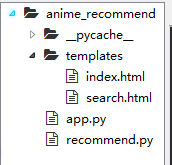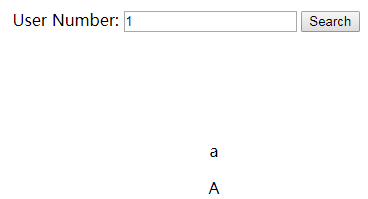推荐系统的实现
一、实验简介
1.1 实验介绍
本节实验我们将在上一节实验的基础上实现推荐系统的核心部分。
1.2 知识点
本节实验中我们将学习并实践下列知识点:
Jinja2模板引擎的使用http请求的处理- 复杂
sql查询的使用 - 简单的推荐算法
二、基础知识
- 路由: Flask 支持用
route()装饰器把一个函数绑定到对应的 URL 上,从而实现路由功能。
如下图代码所示,实现了 URL /hello 和 / 两个地址的访问请求处理:
from flask import Flask
app=Flask(__name__)
@app.route('/')
def index():
return "hello"
if __name__=="__main__":
二、简单推荐算法实现
本节实验中我们实现的推荐算法比较简单,基本思路:
- 找到用户所喜爱的番剧;
- 分析这些番剧的类别(一个番剧可能有多个标签),进行统计排序;
- 找到前三个标签,从数据库中找到同时具有这三个标签的番剧(喜欢的不能再推荐);
- 将番剧相关信息(name,brief)进行展示。
SQL 数据库操作的实现上述的思路1 和 思路2:
#下面代码实现得到用户所喜欢top3类型
sql='''select style_id from
(select user_id,style_id from
(select user_id,anime_id as id from user_anime where user_id=%s) as s
natural join anime natural join
(select anime_id as id,style_id from anime_style) as n
)as temp group by style_id order by count(user_id) desc limit 3;'''%user
其中下图所划去的一行内容对应思路1,即从 user_anime 表中查询用户和喜欢的番剧数据对:
(select user_id,anime_id as id from user_anime where user_id=%s) as s
剩下的两个 select 操作由以下代码共同完成:
#建立三个类别番剧的set(集合),并取交集,即得到同时有三个类型标签的番剧
s=set(anime[str(lis[0])])&set(anime[str(lis[1])])&set(anime[str(lis[2])])
#建立用户喜欢番剧的集合
loveSet=set(love)
#如果系统得到的所有番剧用户均已看过了即loveSet>s,就从Top1类型即最喜欢的类型中挑选一个
#这里我们默认数据库量够大,即用户没有把一个类别的所有番剧看完
if loveSet>s:
s=set(anime[str(lis[0])])
#把集合转化为列表以待随机函数的使用
set_lis=[]
for i in s:
set_lis.append(i)
#从结果中随机挑选
recommend=choice(set_lis)
#直至挑选到用户没看过的
while recommend in love:
recommend=choice(set_lis)
上图中的红线部分较重要,其中第二个红线部分用了 Python 的 Set 数据结构以取交集。love 是喜欢番剧的列表,choice() 函数是随机取一个。while 循环中保证不取与喜欢的重复的,这里还考虑一个问题,就是你得到的交集是喜欢集合的子集,如果不加判断将会导致死循环,所以这种情况拿出来判断,如果出现这种情况就从用户最喜欢类别中拿出一个番剧。
完整代码实现在 recommend.py 文件中,代码如下:
# -*- coding: utf-8 -*-
"""
Created on Thu Aug 25 18:47:40 2016
@author: Albert
"""
from random import choice
import MySQLdb
def recommend(user):
#连接数据库
DB=MySQLdb.connect("localhost","root","1234","recommend")
#获得数据库游标
c=DB.cursor()
#下面代码为实现从数据库中得到用户user所喜欢的番剧编号,以便判断重复
love=[]
#sql语句
sql="select anime_id from user_anime where user_id=%s"%user
c.execute(sql)
#得到结果集
results=c.fetchall()#得到的数据数组赋给results
for line in results:
love.append(line[0])#得到字典赋给新的数组存放
#下面代码实现得到用户所喜欢top3类型
sql='''
select style_id from
(select user_id,style_id from
(select user_id,anime_id as id from user_anime where user_id=%s) as s
natural join anime natural join
(select anime_id as id,style_id from anime_style) as n
)as temp group by style_id order by count(user_id) desc limit 3;'''%user
c.execute(sql)
results=c.fetchall()
lis=[]
anime={}
for (line,) in results:
lis.append(line)
for i in lis:
#从番剧信息的数据库中得到Top3各个类别的所有番剧并存入anime字典中
sql="select anime_id from anime_style where style_id="+str(i)+";"
c.execute(sql)
results=c.fetchall()
anime_lis=[]
for result in results:
anime_lis.append(result[0])
#类型为key,值为存放番剧数据的列表
anime[str(i)]=anime_lis
#建立三个类别番剧的set(集合),并取交集,即得到同时有三个类型标签的番剧
s=set(anime[str(lis[0])])&set(anime[str(lis[1])])&set(anime[str(lis[2])])
#建立用户喜欢番剧的集合
loveSet=set(love)
#如果系统得到的所有番剧用户均已看过了即loveSet>s,就从Top1类型即最喜欢的类型中挑选一个
#这里我们默认数据库量够大,即用户没有把一个类别的所有番剧看完
if loveSet>s:
s=set(anime[str(lis[0])])
#把集合转化为列表以待随机函数的使用
set_lis=[]
for i in s:
set_lis.append(i)
#从结果中随机挑选
recommend=choice(set_lis)
#直至挑选到用户没看过的
while recommend in love:
recommend=choice(set_lis)
dic={}
#得到推荐番剧的相关信息,返回以待使用,显示
sql="select name,brief from anime where id="+str(recommend)+";"
c.execute(sql)
results=c.fetchall()
dic['name']=results[0][0]
dic['brief']=results[0][1]
DB.close()
return dic
四、推荐系统的实现及部署
4.1 app.py 的实现
系统运行的启动我们使用 Flask 实现在 app.py 文件中,详细代码:
# -*- coding: utf-8 -*-
from flask import Flask,render_template,request
import recommend#同文件下导入
app=Flask(__name__)
@app.route('/')#表示传递一个网站,“/”是网站的主目录,也就是http://127.0.0.1:5000/
def index():
return render_template('index.html')
@app.route('/search/')
def search():
#request为全局变量可得到用户输入信息
n=request.args.get('user')
#调用推荐函数
dic=recommend.recommend(n)#recommend下使用推荐算法
#用返回结果进行模板渲染
return render_template('search.html',Data=dic)
if __name__=="__main__":
app.run(debug=True)
其中,render_template 为模板渲染函数,第一个参数为模板,第二个为要传的数据。
4.2 模板文件实现
其中模板文件 index.html 和 search.html 都在 templates 文件夹中(这是 Flask 默认设置的)。templates文件夹在项目工程中。如图:

index.html 页面提供进入系统的首页,及查询输入的数据框,实现代码:
<!doctype html>
</html>
<head><title>Recommend</title>
<style type="text/css">
#body{
text-align:center;
}
#content{
margin-left:25%;
}
</style>
</head>
<body>
<div id="body">
<br/><br/><br/><br/><br/><!--<br/>表示空格-->
<br/><br/><br/><br/><br/>
<form name="input" action="/search/" method="get">
<br/><br/>
User Number:
<input type="text" name="user" />
<input type="submit" value="Search" />
</form>
</body>
</div>
</html>
search.html 页面提供输出结果,实现代码:
<!doctype html>
</html>
<head><title>Recommend</title>
<style type="text/css">
.videoshow{
border-bottom:5px solid #EFEFEF;
padding:20px 10% 20px 20px;
margin:30px 25% 30px 5%;
}
#body{
text-align:center;
}
#content{
margin-left:25%;
}
</style>
</head>
<body>
<div id="body">
<form name="input" action="/search/" method="get">
<br/><br/>
User Number:
<input type="text" name="user" />
<input type="submit" value="Search" />
</form>
<br/><br/>
<div id="content">
<div class="videoshow">
<p class="title">{{Data['name']}}</p>
<p class="Introduction">{{Data['brief']}}</p>
</div>
</div>
</div>
</body>
</html>
现在就完成了整个系统的构建和编码。
4.3 测试启动
在spyder软件,运行 app.py 后,,打开浏览器访问 localhost:5000,你会进入 index.html 界面。
输入用户编号1

点击 search 按钮后,你将会进入 search 界面:

解释一下界面内容,a为推荐番剧的名称,A为推荐番剧的简介。至此,我们的简单推荐系统完成。
五、总结
本次实验我们用 Flask 框架和 Mysql 数据库完成了简单的番剧推荐系统。最后成功为我们输入的用户推荐了一个没有看过的番剧,并通过网页显示出来。相信大家通过此,不仅了解到 Flask 使用和数据库的使用,还懂得推荐系统的基本原理。大家可以对推荐算法进行进一步的优化,以有更好的效果。